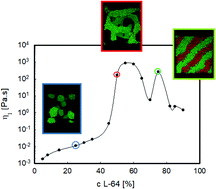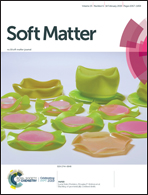An experimental rheological phase diagram of a tri-block co-polymer in water validated against dissipative particle dynamics simulations†
Abstract
Aqueous solutions of tri-block co-polymer surfactants are able to aggregate into a rich variety of microstructures, which can exhibit different rheological behaviors. In this work, we study the diversity of structures detected in aqueous solutions of Pluronic L64 at various concentrations and temperatures by experimental rheometry and dissipative particle dynamics (DPD) simulations. Mixtures of Pluronic L64 in water (ranging from 0 to 90 wt% Pluronic L64) have been studied in both linear and non-linear regimes by oscillatory and steady shear flow. The measurements allowed for the determination of a complete rheological phase diagram of the Pluronic L64–water system. The linear and non-linear regimes have been compared to equilibrium and non-equilibrium DPD bulk simulations of similar systems obtained by using the software LAMMPS. The molecular results are capable of reproducing the equilibrium structures, which are in complete agreement with the ones predicted through experimental linear rheology. The simulations also depict micellar microstructures after long time periods when a strong flow is applied. These structures are directly compared, from a qualitative point of view, with the corresponding experimental results and differences between the equilibrium and non-equilibrium phase diagrams are highlighted, proving the capability of detecting morphological changes caused by deformation in both experiments and DPD simulations. The effect of temperature on the rheology of the systems has been eventually investigated and compared with the already existing non-rheological phase diagram.

- This article is part of the themed collection: Soft Matter Emerging Investigators


 Please wait while we load your content...
Please wait while we load your content...